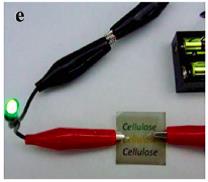Take a look at this week’s selection! These articles are available free for a limited time:
Photoelectrochemistry of core–shell tandem junction n–p+-Si/n-WO3 microwire array photoelectrodes
Matthew R. Shaner, Katherine T. Fountaine, Shane Ardo, Rob H. Coridan, Harry A. Atwater and Nathan S. Lewis
DOI: 10.1039/C3EE43048K, Paper
Graphene oxide derivatives as hole- and electron-extraction layers for high-performance polymer solar cells
Jun Liu, Michael Durstock and Liming Dai
DOI: 10.1039/C3EE42963F, Review Article
α-Fe2O3 multi-shelled hollow microspheres for lithium ion battery anodes with superior capacity and charge retention
Simeng Xu, Colin M. Hessel, Hao Ren, Ranbo Yu, Quan Jin, Mei Yang, Huijun Zhao and Dan Wang
DOI: 10.1039/C3EE43319F, Communication
Ultra-long anatase TiO2 nanowire arrays with multi-layered configuration on FTO glass for high-efficiency dye-sensitized solar cells
Wu-Qiang Wu, Yang-Fan Xu, Cheng-Yong Su and Dai-Bin Kuang
DOI: 10.1039/C3EE42167H, Communication
Energy demand and emissions of the non-energy sector
Vassilis Daioglou, Andre P. C. Faaij, Deger Saygin, Martin K. Patel, Birka Wicke and Detlef P. van Vuuren
DOI: 10.1039/C3EE42667J, Analysis
π-Extended low bandgap polymer based on isoindigo and thienylvinylene for high performance polymer solar cells
Eui Hyuk Jung and Won Ho Jo
DOI: 10.1039/C3EE42297F, Communication
High performance silicon-based anodes in solid-state lithium batteries
Rinlee B. Cervera, Naoki Suzuki, Tsuyoshi Ohnishi, Minoru Osada, Kazutaka Mitsuishi, Takayoshi Kambara and Kazunori Takada
DOI: 10.1039/C3EE43306D, Communication
Metal–organic frameworks as solid magnesium electrolytes
M. L. Aubrey, R. Ameloot, B. M. Wiers and J. R. Long
DOI: 10.1039/C3EE43143F, Communication
Enhancing SOFC cathode performance by surface modification through infiltration
Dong Ding, Xiaxi Li, Samson Yuxiu Lai, Kirk Gerdes and Meilin Liu
DOI: 10.1039/C3EE42926A, Review Article
Towards optimisation of photocurrent from fullerene excitons in organic solar cells
Stoichko D. Dimitrov, Zhenggang Huang, Florent Deledalle, Christian B. Nielsen, Bob C. Schroeder, Raja Shahid Ashraf, Safa Shoaee, Iain McCulloch and James R. Durrant
DOI: 10.1039/C3EE42607F, Paper
Self-supported Li4Ti5O12 nanosheet arrays for lithium ion batteries with excellent rate capability and ultralong cycle life
Shuai Chen, Yuelong Xin, Yiyang Zhou, Yurong Ma, Henghui Zhou and Limin Qi
DOI: 10.1039/C3EE42646G, Paper












 The latest issue of EES is now online. You can read the full issue
The latest issue of EES is now online. You can read the full issue  Philip Heptonstall, Anders Lyngfelt, Zen Makuch, Enzo Mangano, Richard T. J. Porter, Mohamed Pourkashanian, Gary T. Rochelle, Nilay Shah, Joseph G. Yao and Paul S. Fennell
Philip Heptonstall, Anders Lyngfelt, Zen Makuch, Enzo Mangano, Richard T. J. Porter, Mohamed Pourkashanian, Gary T. Rochelle, Nilay Shah, Joseph G. Yao and Paul S. Fennell






